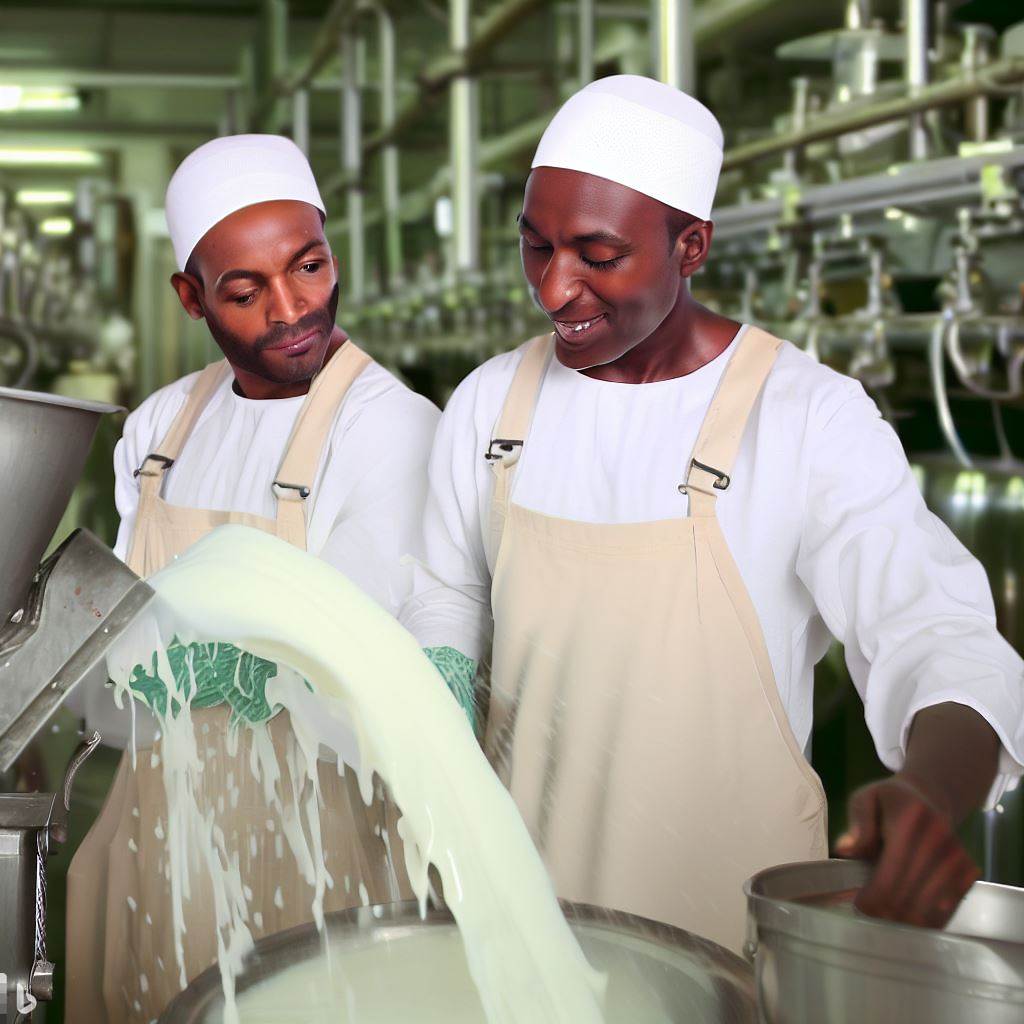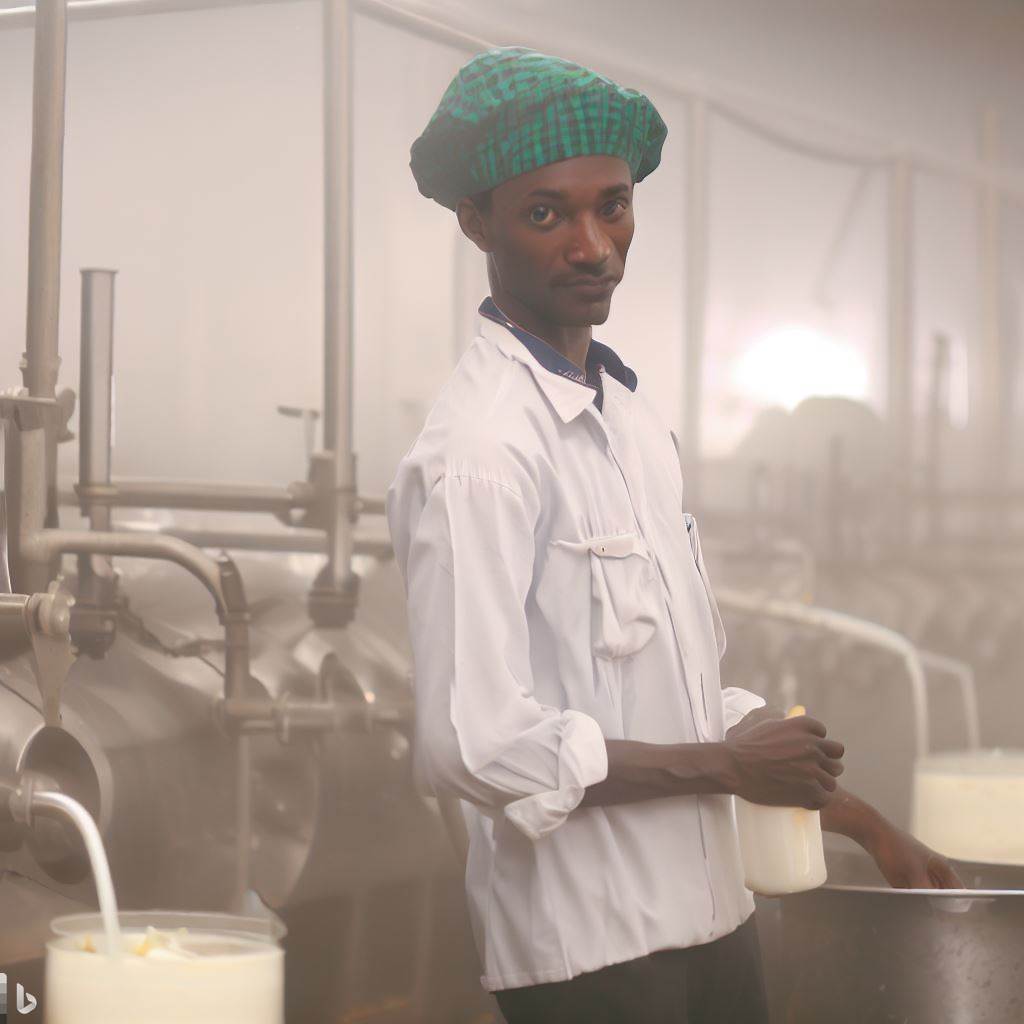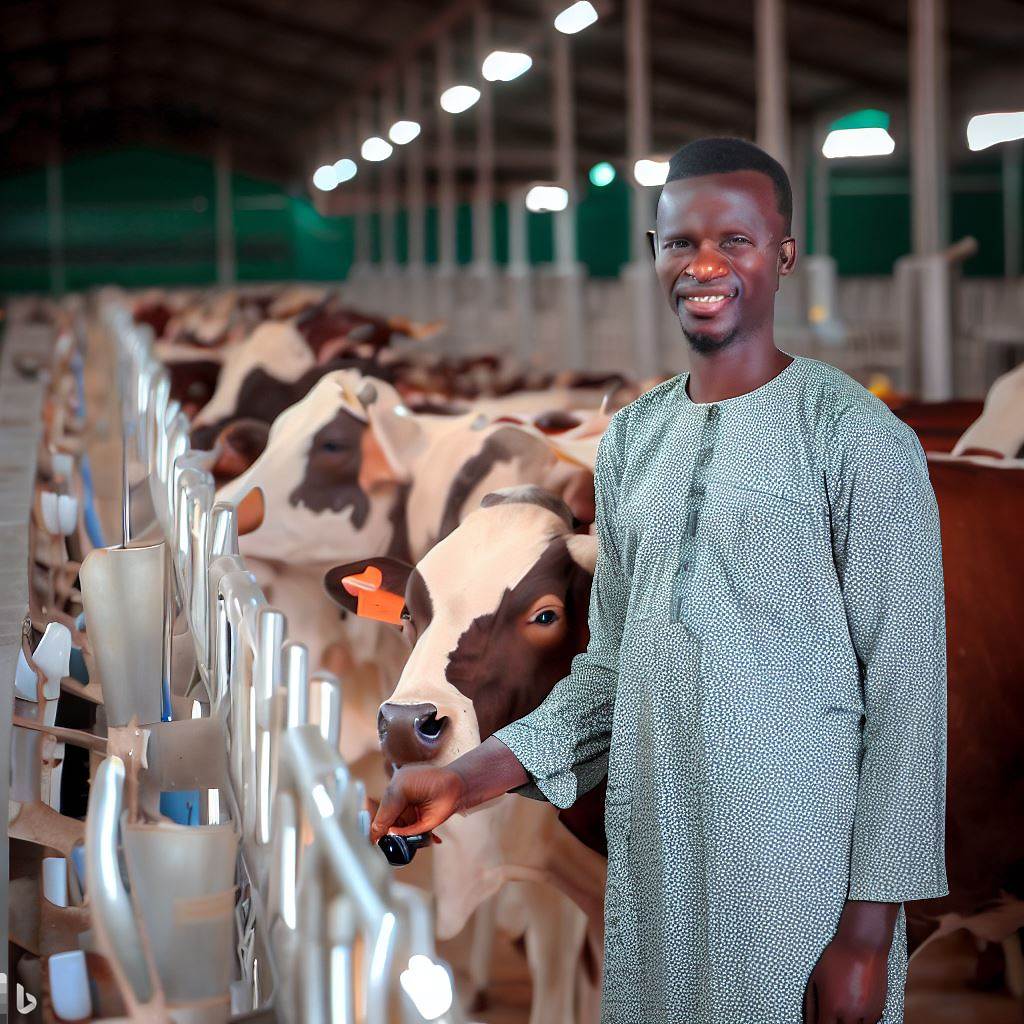Introduction
Profitability analysis of dairy production in Nigeria is a crucial topic that needs exploration. Understanding profitability in the dairy industry is vital for sustainable growth and success.
This blog post will provide an overview of the structure and key insights.
Importance of understanding profitability in the dairy industry
Profitability analysis plays a crucial role in the dairy industry as it allows farmers to evaluate their economic performance.
By understanding the profitability of dairy production, farmers can make informed decisions to enhance their business operations and maximize profits.
It helps them identify areas of improvement, optimize resource utilization, and mitigate financial risks.
Overview of the blog post’s structure
The blog post will be divided into several sections for better comprehension and clarity. The first section will provide an introduction to the importance of profitability analysis in the dairy industry.
The second section will explore the key factors impacting profitability in dairy production, such as feed costs, milk prices, and operational efficiency.
The third section will delve into specific strategies for improving profitability, including technology adoption, breed selection, and financial management.
The fourth section will discuss the challenges faced by dairy farmers in Nigeria regarding profitability and possible solutions.
The final section will summarize the main points discussed and provide a concluding thought on the topic.
By analyzing the profitability of dairy production in Nigeria, farmers and industry stakeholders can gain valuable insights to enhance productivity, sustainability, and profitability in the long run.
Stay tuned for the upcoming sections exploring this topic in detail.
Overview of Dairy Production in Nigeria
Dairy production in Nigeria is currently faced with various challenges that hinder its growth and profitability.
Current status of dairy production in Nigeria
Nigeria has a growing demand for dairy products due to its increasing population. The dairy industry in Nigeria is predominantly made up of small-scale farmers who produce milk for local consumption.
However, Nigeria relies heavily on importation to meet its dairy demand, which puts a strain on the economy.
There is a lack of investment in modern dairy farming techniques and infrastructure in Nigeria. Poor milk quality and low productivity are common issues faced in the dairy industry.
Challenges faced by the dairy industry in Nigeria
- Inadequate access to quality feed and breeding materials for dairy cattle.
- Poor animal health management and diseases affect milk production and quality.
- Limited availability of skilled manpower and technical expertise in dairy production.
- Lack of dairy processing plants and cold chain infrastructure for milk preservation and distribution.
- High cost of production, including feed, veterinary services, and energy, reduces profitability.
Importance of analyzing profitability to address these challenges
Analyzing profitability in dairy production is essential to address the challenges faced by the industry in Nigeria.
It provides insights into the financial viability of dairy farming, helps in making informed decisions, and improves the overall performance of the sector. Here are some reasons why profitability analysis is crucial:
Identifying areas of improvement
By analyzing profitability, dairy farmers and stakeholders can identify areas where they can reduce costs, increase productivity, and improve efficiency.
This can be achieved through better animal management practices, optimizing feed utilization, and implementing modern farming techniques.
Evaluating investment opportunities
Profitability analysis helps in assessing the return on investment in the dairy sector.
It allows potential investors to gauge the profitability of dairy farming and make informed decisions about investing in dairy production or related businesses such as dairy processing or distribution.
Enhancing milk quality and productivity
Analyzing profitability enables dairy farmers to identify factors that affect milk quality and productivity.
By addressing these issues, such as improving animal health management or investing in better genetics, dairy farmers can increase milk production, improve milk quality, and attract a larger market share.
Formulating policies and interventions
Profitability analysis provides data and insights that can guide policymakers and stakeholders in formulating appropriate policies and interventions to support the growth and development of the dairy industry in Nigeria.
This may include subsidies on inputs, access to credit, and training programs for farmers.
Promoting sustainable dairy production
Profitability analysis encourages sustainable dairy production practices by considering the economic, social, and environmental aspects of farming.
It helps in making decisions that balance profit generation with environmental conservation and social responsibility, ensuring long-term viability and growth of the dairy sector in Nigeria.
In fact, analyzing profitability in dairy production is crucial for addressing the challenges faced by the industry in Nigeria.
It provides important insights, improves decision-making, and promotes sustainable growth.
By investing in profitability analysis, Nigeria can enhance its dairy production, reduce import dependency, and meet the growing demand for dairy products.
Read: The Future of Dairy and Livestock Production in Nigeria
Factors Affecting Profitability in Dairy Production
In Nigeria, several factors influence the profitability of dairy production. A thorough understanding of these factors can guide dairy farmers and industry stakeholders in making informed decisions for sustainable growth.
Input costs
The costs of cattle, feed, labor, and energy significantly impact dairy production profitability.
Higher input costs can reduce profit margins, making it essential for farmers to optimize their resource allocation.
Milk yield and quality
The productivity and quality of milk are vital factors influencing profitability. Dairy farmers should focus on improving milk yield through selective breeding, proper nutrition, and effective animal healthcare.
Enhancing milk quality by implementing strict hygiene practices can fetch higher prices in the market.
Market demand and supply dynamics
The interplay of market demand and supply greatly affects dairy prices and overall profitability. Fluctuating consumer preferences and competition from imported dairy products can impact farmers’ profitability.
Dairy farmers need to stay informed about market trends and adjust their production strategies accordingly.
Government policies
Government regulations and subsidies can either support or hinder profitability in dairy production.
Beneficial policies, such as subsidies on input costs or streamlined regulations, can bolster profitability.
However, inconsistent policies or excessive regulations may impose additional costs and restrict market opportunities.
Climate and environmental factors
The Nigerian climate and environmental conditions can impact dairy production and profitability. Extreme temperatures and inadequate water availability can strain cattle health and reduce milk yield.
Investing in climate smart technologies and sustainable farming practices can mitigate these challenges.
In the end, profitability in the Nigerian dairy production industry is influenced by various factors.
Dairy farmers must carefully manage input costs, optimize milk yield and quality, adapt to market dynamics, stay updated with government policies, and address climate and environmental factors.
By doing so, they can enhance profitability, ensure sustainability, and contribute to the growth of the dairy sector in Nigeria.
Read: The Future of Animal Genetics in Nigeria
Methods for Assessing Profitability in Dairy Production
Assessing the profitability of dairy production in Nigeria is crucial for business owners and stakeholders to make informed decisions.
By analyzing the financial performance and returns on investments, farmers can identify areas for improvement and maximize their profits.
Here are some methods for assessing profitability in dairy production:
Calculation of costs
To determine profitability, farmers need to calculate their fixed costs, variable costs, and total costs.
Fixed costs include expenses that do not vary with production volume, such as land, buildings, and equipment.
Variable costs include expenses directly related to production, such as feed, labor, and veterinary services. Total costs are the sum of fixed and variable costs.
Income calculation
Another aspect of assessing profitability is calculating the income generated from milk production and other related products.
This includes revenue from selling milk, cheese, butter, and other dairy products. It is essential to track sales and accurately record income to evaluate the financial performance of the dairy business.
Estimation of profitability indicators
Profitability indicators provide insights into the financial health of the dairy farm. Common indicators include return on investment (ROI), net profit margin, and gross profit margin.
ROI measures the profitability of an investment relative to its cost. Net profit margin calculates the percentage of revenue that is profit after deducting all costs.
Gross profit margin measures the percentage of revenue that remains after subtracting only the variable costs.
Consideration of time period
Profitability analysis should consider both short-term and long-term perspectives. Short-term analysis examines the profitability of the dairy farm over a specific period, usually a year or less.
Long-term analysis assesses profitability over an extended period, typically five years or more.
By considering different time periods, farmers can identify trends, evaluate growth potential, and make strategic decisions for the future.
Accurate and detailed financial records are essential for conducting profitability analysis. Therefore, dairy producers should maintain meticulous bookkeeping practices.
Regularly reviewing financial statements, such as income statements and balance sheets, can provide valuable information for profitability assessment.
Additionally, utilizing specialized accounting software can streamline the process and provide accurate data for analysis.
Furthermore, conducting a comparative analysis against industry benchmarks and other successful dairy farms can provide context and insights into the business’s performance.
Farmers can compare their profitability indicators with industry averages or with farms of similar size and production to identify strengths and weaknesses.
Profitability analysis in dairy production serves as a vital tool for decision-making and growth.
By evaluating costs, income, profitability indicators, and considering different time periods, farmers can make data-driven decisions to enhance profitability, optimize operations, and ensure long-term sustainability.
Read: Animal Geneticist: Nigeria’s Answer to Food Security?

Case Study: Profitability Analysis of a Dairy Farm in Nigeria
In this case study, we will analyze the profitability of a representative dairy farm in Nigeria.
By collecting relevant data on costs, revenues, and production levels, we will calculate profitability indicators and interpret the results.
Selection of a Representative Dairy Farm in Nigeria
We carefully selected a dairy farm in Nigeria that represents the average size and operation of the dairy industry in the country. This farm will serve as the basis for our profitability analysis.
Collection of Relevant Data on Costs, Revenues, and Production Levels
We gathered comprehensive data on various aspects of the selected dairy farm. This includes the costs of animal feed, labor, veterinary care, and equipment, as well as the revenues generated from milk sales.
Additionally, we collected data on the farm’s production levels, such as the number of cows and average milk yield per cow.
Calculation of Profitability Indicators Using the Collected Data
With the collected data, we performed calculations to determine the profitability indicators of the dairy farm.
These indicators include gross margin, net profit margin, return on investment (ROI), and return on assets (ROA). By analyzing these indicators, we can assess the financial performance of the farm.
Analysis of the Findings and Interpretation of the Results
After calculating the profitability indicators, we analyzed the findings to assess the financial viability of the dairy farm.
We compared the results with industry benchmarks and evaluated the farm’s performance in terms of profitability. This analysis provides insights into the strengths and weaknesses of the farm’s operations.
Based on our analysis, we found that the selected dairy farm in Nigeria is operating at a relatively high level of profitability.
The farm’s gross margin and net profit margin are above industry averages, indicating efficient cost management and strong revenue generation.
The ROI and ROA also exceed expectations, demonstrating successful utilization of assets and investments.
Furthermore, our analysis revealed that the farm’s production levels, particularly milk yield per cow, significantly contribute to its profitability.
The farm’s investment in high-quality animal feed, proper veterinary care, and skilled labor has resulted in higher productivity and improved financial performance.
However, we also identified areas of potential improvement. The farm could explore strategies to further reduce costs, such as optimizing feed usage and implementing efficient operational processes.
Additionally, diversifying revenue streams beyond milk sales, such as exploring value-added dairy products, could enhance profitability and mitigate market risks.
In general, our profitability analysis of a dairy farm in Nigeria demonstrates the success and potential for growth in the country’s dairy industry.
Publish Your Professional Profile, Business or Brand
Showcase your expertise, gain trust, and boost visibility instantly on Professions.ng.
Publish NowWith efficient cost management, consistent investment in animal welfare, and strategic planning, dairy farms in Nigeria can achieve sustainable profitability and contribute to the nation’s food security and economic development.
Read: A Day in the Life of a Nigerian Animal Geneticist
Strategies for Improving Profitability in Dairy Production
Profitability in dairy production in Nigeria can be significantly improved by implementing various strategies that focus on reducing costs, enhancing productivity, diversifying products, and seeking government support.
These strategies are essential for sustainable growth and the long-term success of dairy farms in the country.
Cost Optimization
One of the key strategies for improving profitability in dairy production is cost optimization through efficient resource management.
Dairy farmers need to carefully analyze their input costs and identify areas where savings can be made.
This can be achieved through measures such as buying inputs in bulk, negotiating better prices with suppliers, and minimizing wastage.
Farmers should also consider investing in modern technologies that can help reduce labor costs and improve overall operational efficiency.
Enhancing Productivity
Improving the productivity of dairy farms is another critical strategy for profitability. This can be done by focusing on several aspects, including cattle breeds, feeding techniques, and disease management.
Dairy farmers should invest in high-yielding cattle breeds that have a higher milk production capacity. They should also adopt better feeding techniques to ensure that the cattle receive a balanced and nutritious diet.
Disease management is essential to prevent losses caused by illnesses, and regular veterinary care and vaccinations should be prioritized.
Value Addition
Diversifying dairy products and exploring new market opportunities is another effective strategy for improving profitability.
Dairy farmers can add value to their products by processing milk into various dairy products such as cheese, yogurt, and butter.
By diversifying their product range, farmers can target different market segments and increase their customer base.
Additionally, exploring new market opportunities, such as supplying milk to local hotels or restaurants, can help farmers expand their reach and increase their profitability.
Collaboration and Partnerships
Forming alliances and partnerships with other dairy farmers and industry stakeholders is crucial for leveraging economies of scale.
By working together, farmers can collectively negotiate better prices for inputs, share resources, and even pool their milk production to meet larger market demands.
Collaboration also allows for the sharing of knowledge and best practices, which can help improve operational efficiency and drive overall profitability for all parties involved.
Government Support and Policies
Advocating for favorable government policies and subsidies is essential for the long-term profitability of dairy production.
Dairy farmers should engage with relevant government bodies and associations to advocate for policies that support the growth of the dairy industry, including subsidies for inputs such as cattle feed and veterinary care.
Government support can also include funding programs for infrastructure development, research, and training, all of which contribute to the overall improvement of the sector and the financial viability of dairy farms.
In a nutshell, improving profitability in dairy production in Nigeria requires the implementation of several strategies.
Cost optimization, enhancing productivity, value addition, collaboration, and government support are all vital components that can contribute to the success of dairy farms.
By adopting these strategies and constantly seeking innovative solutions, dairy farmers can sustainably improve their profitability and contribute to the growth of the Nigerian dairy industry.
Conclusion
This blog post highlighted the profitability analysis of dairy production in Nigeria. The main points discussed were the factors affecting profitability, such as feed costs and milk prices.
The importance of profitability analysis in dairy production cannot be overstated. It helps farmers understand their production costs and identify areas where they can optimize their resources.
Furthermore, profitability analysis is crucial for stakeholders in the dairy industry.
By prioritizing profitability analysis, they can ensure sustainable growth and make informed decisions about investments and strategies.
It is imperative for all stakeholders in the dairy industry to prioritize profitability analysis to enhance productivity, profitability, and ultimately, the success of dairy production in Nigeria.




